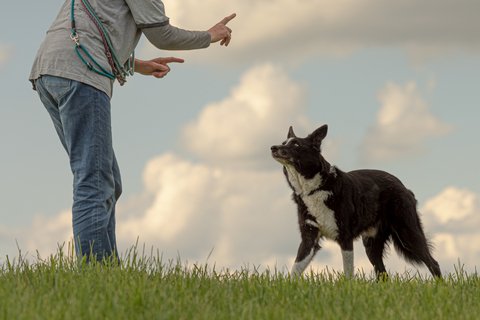Whether it is the frustration of a new puppy, taking on a challenging rescue pooch, or dealing with your rambunctious young adult dog, many people wonder at some point if ALL dogs can be trained. If you have found yourself asking the same question, and might be wondering if you ended up with a dog for which training is hopeless, this is the article for you!
The short answer to the question of “can all dogs be trained” is YES! But you also need to ask what you want to train your dog to do, and how easily can that training be accomplished. While all dogs have the ability to learn, some present more significant challenges in doing so.
Some breeds are easy to train with traditional methods, while others may require more creativity to convince them to do what you ask. Your dog’s age can also be a factor, as habits are hard to break for dogs, just like humans! Setting reasonable expectations for your individual dog may be the most crucial part of determining if, in fact, it can be trained. Let’s delve a little deeper into the things that make dogs easier or more challenging to train.
Table of Contents
The Age of Your Dog
The old saying that “you can’t teach an old dog new tricks” is just not true. Perhaps a better saying to keep in mind is, “old habits die hard.” Dogs are capable of learning throughout their entire lives. But if the training you are attempting to do on your older dog goes against habits that they have been accustomed to for a long time, it can be much more difficult.

Aside from trying to teach your older dog new things that may go against behaviors and rules they have followed for years, some medical issues may increase the difficulty of training your senior pet. Cognitive dysfunction syndrome (CDS) is a neurobehavioral disorder in older dogs that can affect their daily life in ways that appear similar to dementia in humans. If your senior dog is suffering from this, training may be more difficult. Today, there are supplements and foods on the market that may help with CDS, such as Senilife and Purina ProPlan Veterinary Diet NC Neurocare. So long as your older dog is not suffering from severe CDS, training can be accomplished with patience and consistency!
Training a puppy is often easier than re-training an adult dog, but there are challenges with that as well! I recommend that you begin training your new pup as soon as you bring him or her home.
Be consistent with your rules and your behavior expectations. It is not fair to change the rules for your dog as they grow bigger – set your “house rules” and maintain those throughout your dog’s life for the best results. Keep in mind that puppies have short attention spans, and your training sessions should always be quick and fun for the pup. You will also want to be careful of certain times in their development that may make training more difficult, such as during teething and fear periods.
The Breed of Your Dog
Humans have been selectively breeding dogs for particular physical traits and working abilities for several hundred years. Because of this, certain breeds tend to learn new behaviors quicker than others.
That is especially true of dogs that were bred with work with humans, as opposed to dogs that do their jobs independently of humans.
If you are working with a mixed breed dog of unknown origin, you won’t be able to distinguish their typical learning style as efficiently as you could with a purebred dog. That doesn’t mean that mixed breed dogs are easier or more difficult to train, it just means that you will have to work with the dog’s individual personality to determine the best training styles for that particular dog.
Many lists are available on the internet, ranking the “smartest” and “dumbest” breeds of dogs. Unfortunately, these lists often conflict with each other, so they are not an accurate way to label the different breeds of dogs.

Many times these lists will have several terrier and hound breeds listed on the “dumb” list. Having lived with hounds for years, I completely disagree with this conclusion. Personally, I’ve found hound breeds (sighthound breeds in particular) to be incredibly smart! Afghan Hounds are typically ranked near the top of the “dumbest” or most difficult to train breeds; however, every Afghan Hound owner I know considers their dogs to be almost human-like in their intelligence. However, sighthounds are still rather primitive by nature, so their intelligence is often shown in different ways. For instance, they often don’t have an innate desire to please their humans. That may make training more challenging for their owners, as they will need to convince the dog that is it worth their while to do what is being asked of them. I have never had any difficulty teaching my Pharaoh Hounds new behaviors; the challenge comes in convincing them to do those behaviors I’ve taught them each time I ask them!
I often tell my clients that obedience and intelligence are NOT synonyms. A dog that does precisely what they are told to do each and every time is definitely obedient. But, it is not necessarily intelligent, as following all directions without asking questions isn’t always the smartest thing to do.
Breeds of dogs that have worked in conjunction with humans for centuries (such as most hunting breeds, many working breeds, and some herding breeds) often make the list of the “smartest” breeds. That is because they looked to their humans for directions and were not encouraged to make their own decisions. This trait often makes training much easier and increases their reliability in performance.
Border Collies, Poodles, Labrador Retrievers, and Golden Retrievers consistently rank among the “smartest” and easiest to train breeds. That is likely due to their background in looking to their owners for direction.
Dogs with Disabilities
While all dogs can be trained to some degree, if your dog has a physical or mental disability, that can make training more difficult. I have already mentioned some mental disabilities that may develop with age, but there are others that can hinder your dog’s ability to learn quickly.
A dog that has a hearing impairment will obviously not respond to verbal commands. That is not a problem if you can adjust your training techniques to use hand signals instead of verbal signals. In fact, it is often easier, as dogs respond much quicker to body language than they do the spoken word. However, there will be a more significant challenge getting your dog’s attention in order to give him or her the hand signal. Therefore, a breed that is more focused on humans, in general, will not have as much of a disadvantage in training with a hearing problem as a more independent dog would have.
Blind dogs can hear your verbal cues, but they will not be able to read body language and cannot mimic behaviors, which could cause some significant difficulties in training. Again, with patience and the proper training techniques, even dogs with little to no sight are still able to learn basic behaviors and rules.
Physical disabilities such as missing limbs or arthritis may delay your dog’s response to your commands if what you ask them causes pain or discomfort. However, those physical disabilities do not interfere with their ability to learn, only with their ability to comply quickly and in the manner desired. If you are working with a dog that suffers from one of these disabilities, you will need to adjust your requests to make it easier for the dog to comply.
In my opinion, fear and anxiety also fall under the disabilities heading. A dog that is under extreme stress or fear is not able to think rationally. Their bodies kick into a fight or flight mode, and they act instinctively. That can happen even if the threat is only perceived by the dog and not an actual threat. It is nearly impossible to train a dog when they are in this mode. Therefore, a continually fearful dog will be extremely difficult to train unless you can get him or her out of that mode and into a more comfortable, relaxed state of mind.
Methods of Training
Although all dogs can be trained to some degree, the method of training that works most effectively will vary significantly from dog to dog. Thankfully, there are many different training techniques available. If you have a dog that you feel is not responding to training, you may just need to alter your training style.
Over the years, training has shifted from a lot of compulsion (such as with the Koehler method) to methods that use only positive reinforcement (such as clicker training illustrated in Don’t Shoot The Dog). While both ends of the training spectrum have proven successful with some dogs, most dogs will respond best to training methods somewhere between these two extremes. Your challenge will be finding the type of training that your dog will respond best to.
If you have taken your dog to a class that was not successful, don’t give up! Try a different class with a different trainer! Or, perhaps a group class setting isn’t the best situation for your dog, and you will need to experiment with a private trainer.

As you search for a trainer to help you, please keep in mind that all trainers are not equal! You will want to interview several trainers to find one that has experience training challenging dogs. Be honest with the trainer as you describe your situation and tell them the methods you have tried and what has worked, as well as what hasn’t worked. I believe the best trainers are those familiar with many different training techniques and don’t just focus on one way of doing things. While they may have their favorite style of training, if that way doesn’t work for your particular dog, it will be useless to you. You will need to find a trainer whose preferred method works well for your dog, or you will need to find a trainer that is flexible and able to try several different methods to find the best one for your situation.
As I mentioned above, many times the dogs that people deem untrainable are actually very intelligent. They just don’t respond to traditional training methods. If your dog is not interested in treats, clicker training will not work for you. If you have a dog that isn’t food motivated at all, you will likely struggle with most of the reward-based training methods. That is unless you can find a reward that your dog wants other than treats, such as a toy. For those dogs that you are unable to find a reward for, you might have to explore some of the more compulsion-based training methods.
On the other hand, some dogs do not do well at all with any compulsion. They may shut down completely when corrected, or even become aggressive when physically corrected. For those dogs, reward-based training may very well be the best answer!
Many times, training issues that people encounter are not based on the dog at all, but instead on the messages they are receiving from the humans in the household. A dog that is continually being given mixed messages will have a tough time understanding what is being asked of them. When this happens, you will usually get one of three responses; those responses are based on the dog’s personality.
- The dog shuts down. A submissive, soft-tempered dog that doesn’t understand what is being asked of him or her will often just give up. They will show this frustration by offering submissive behaviors such as rolling on their back, lifting a paw, looking away, or in severe cases, even hiding from the owner when training starts.
- The dog becomes aggressive. A strong-willed dog that gets mixed messages will sometimes begin to fight back. That is the case, especially with dogs that are given substantial corrections that they consider unfair and confusing. Using force while training a dog like this will often result in the owner getting bit.
- The dog ignores the commands. That is the complaint I hear most often. If the owners are not clear with their directions and have a happy-go-lucky dog that isn’t easily offended by corrections or verbal reprimands, the dog ignores the requests. They have decided that since they don’t understand what is being asked, and the consequences are not that bad for disobeying, why bother trying to figure out what the owner wants from them.
The best remedy for a dog that is not responding to the training you are offering is to try a different style of training!
Unrealistic Expectations
Asking if all dogs can be trained is an easy question to answer, but it is not a fair question to ask. You need to ask WHAT it is that you want to train your dog. While all dogs can learn, not all dogs are equipped to be perfect off-leash obedience competition dogs, nor are all dogs able to be service dogs or police dogs. Training your dog involves setting expectations, and if you want to be successful, you will need to set reasonable expectations.
For instance, if you are dealing with a dog that has a very high prey drive (such as the breed that I have), expecting them to be 100% reliable off-leash is not a reasonable expectation. I have to take into account that Pharaoh Hounds were bred to hunt rabbits, which is an instinct that runs deep in their DNA. While I can often convince my dogs that following my commands is in their best interest and will result in a treat (which they REALLY like) if a rabbit crosses their path, that treat becomes incredibly insignificant to them, and their instincts take over.
If you have a shy dog that is comfortable at home, but just doesn’t enjoy meeting many new people in new environments, that dog is not likely to be a good candidate for therapy dog training. That is not to say that with patience and proper training, you can’t create a dog that will tolerate going out in public and occasionally receiving a pet from a stranger; but, it is not fair to try and turn them into something that they are not. If you want to put it into human terms, I believe most, if not all, humans can learn to play a simple song on the piano. However, that task is much easier for some than others, and only some people have the gift to become a concert pianist.
You should be able to teach your dog basic manners and simple commands, but for any advanced or specialized training, you will need to take your dog’s personality into account. Set reasonable training goals that fit your lifestyle and, more importantly, your dog’s temperament if you want to succeed. Once you have taken into account the breed and activity level of your dog, what motivates your dog, and the training style that works best for you (and your dog), you will need to put in the time and practice to achieve your goals. With patience and consistency and PRACTICE, you should be able to reach reasonable training goals with ANY dog!




